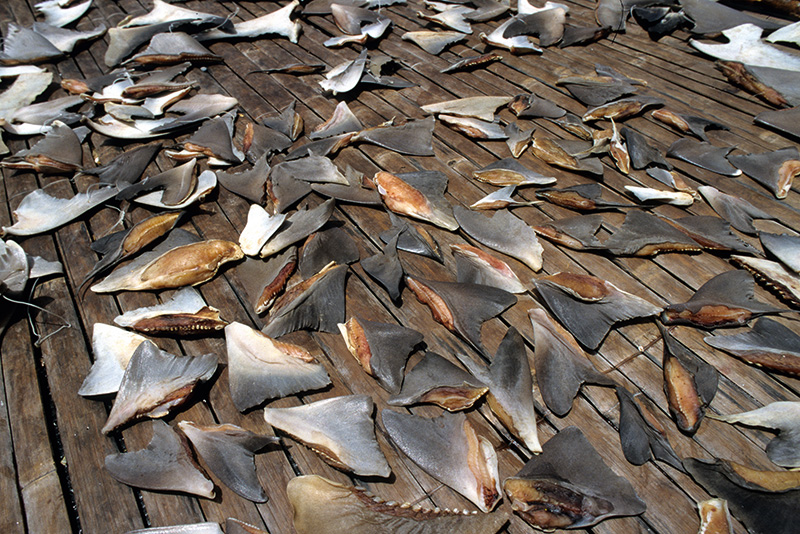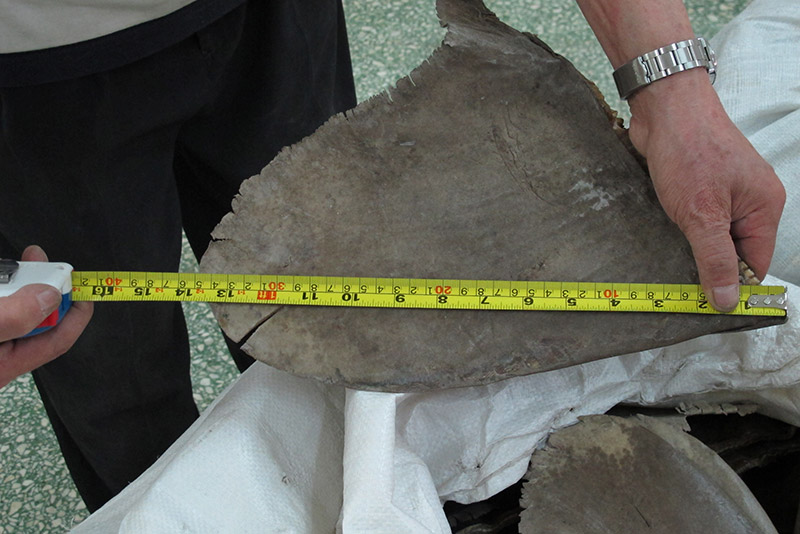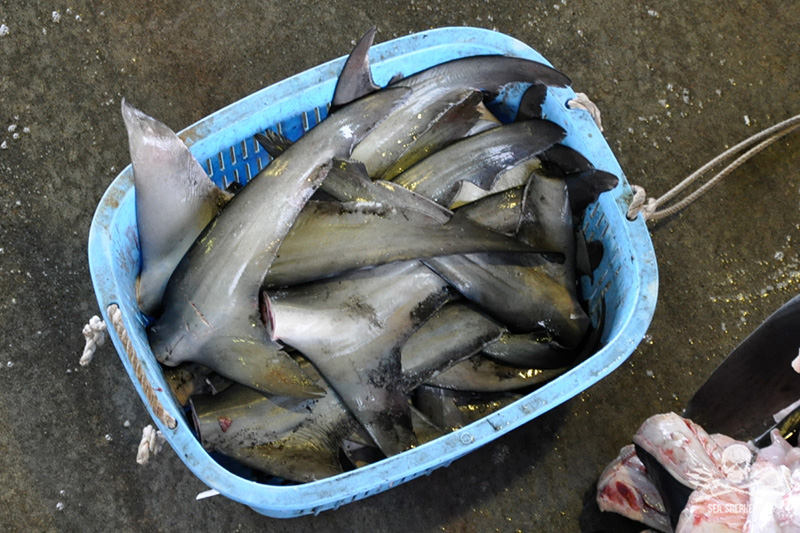Backgrounds, Facts & Statistics
Transport of loose fins – cover-up made easy
The trade with loose shark fins over Europe is allowed according to current legislation – as long as it is not the 12 shark species protected by CITES. When trading whole shark bodies, these protected shark species can still be identified relatively easily, but if only shark fins are transported, even experts encounter their limits. One of the reasons for this is that the shape and colour of the fins change during the drying process and that the size proportion is missing without the corresponding shark body. In addition, the traded fins are usually a mixture of different age groups – this represents a further difficulty, as in young sharks important characteristics are often not yet so distinctive.
The confiscation of three tons of shark fins at Frankfurt Airport in the spring of 2018 is an example of how easily trade in protected shark species can be covered up in this way. Among the fins, which were to be exported from Mexico to Hong Kong via Europe, there were also several protected CITES species. Some of these species can be identified by unique fin characteristics, which are also facilitated by special programs such as FAO’s iSharkFin software[1]. However, many species can no longer be differentiated in this way and complex DNA methods must be used.
A scientific study from 2018 also shows that the fins of many CITES-listed species are still being traded, often without the necessary documentation. By means of DNA analysis, shark fins sold in Hong Kong were examined and for the most part identified as protected species[2]. Hong Kong is the main hub for shark fins.
The extension of the “Fins Naturally Attached” regulation facilitates the identification of sharks for import and export and prevents the cover-up of illegally traded species. In addition, there is clear evidence that many of the batch traded shark fins have been separated from the animal by finning – this will also be impeded by an expansion of the Regulation and the trade in sharks as a whole would become significantly less attractive.
[1] Food and Agriculture Organization of the United Nations: SharkFin Guide: identifying sharks for their fins
[2] Cardeñosa, D. et al., 2018. CITES-listed sharks remain among the top species in the contemporary fin trade. Conservation Letters, 07
Identifying fins – a complex DNA procedure
The identification of shark fins in imports and exports is important to detect illegal trade and to take criminal action if necessary. Experts can help, but in many cases the species can only be clearly identified by DNA analysis. The method known as DNA barcoding works in a similar way to genetic fingerprinting in criminology: the DNA of shark fins is isolated, processed and sequenced. Subsequently, individual gene segments are compared with a database and the shark fins can be attributed to their species on the basis of species-specific genetic characteristics[1].This method has also proven, for example, that many shark and ray species classified as threatened are still available on the international market[2] and that British Fish & Chips products contain shark meat, including endangered species.
Although DNA barcoding has been used successfully in science and for the protection of endangered species for several years, the process is still labour-intensive and costly. DNA barcoding of large quantities of traded shark fins, such as the three tons of confiscated shark fins at Frankfurt Airport in 2018, is therefore very costly. Although this method is well suited for spot checks and scientific studies, it is not ideal for routine testing of large quantities.
Restricting shark trade to whole bodies promises to make it much easier to identify protected shark species during routine checks. The costly DNA analysis would then be used only in exceptional cases.
[1] Food and Agriculture Organization of the United Nations: SharkFin Guide: identifying sharks for their fins
[2] Cardeñosa, D. et al., 2018. CITES-listed sharks remain among the top species in the contemporary fin trade. Conservation Letters, 07
Sharks listed as endangered by the IUCN – as of 07 August 2019
| Note | Latin name | Common name | Trend | IUCN classification |
| Alopias pelagicus | Pelagic Thresher Pazifischer Fuchshai | ↘ | vu | |
| Alopias superciliosus | Bigeye Thresher Shark Großaugen Fuchshai | ↘ | vu | |
| Alopias vulpinus | Common Thresher Shark Gemeiner Fuchshai | ↘ | vu | |
| Atelomycterus baliensis | Bali Catshark Bali-Katzenhai | ? | vu | |
| Brachaelurus colcloughi | Colclough‘s Shark Blaugrauer Blindhai | ↘ | vu | |
| Carcharhinus albimarginatus | Silvertip Shark Silberspitzenhai | ↘ | vu | |
| Carcharhinus borneensis | Borneo Shark Borneohai | ? | en | |
| new | Carcharhinus dussumieri | Whitecheek Shark Weißwangen-Hai | ↘ | en |
| Carcharhinus falciformis | Silky Shark Seidenhai | ↘ | vu | |
| Carcharhinus hemiodon | Pondicherry Shark Pondicherryhai | ? | cr | |
| Carcharhinus leiodon | Smoothtooth Blacktip Shark GlattzahnSchwarzspitzenhai | ↘ | en | |
| Carcharhinus longimanus | Oceanic Whitetip Shark WeißspitzenHochseehai | ↘ | vu | |
| Carcharhinus obscurus | Dusky Shark Schwarzhai | ↘ | vu | |
| Carcharhinus plumbeus | Sandbar Shark Sandbankhai | ↘ | vu | |
| Carcharhinus signatus | Night Shark Atlantischer Nachthai | ↘ | vu | |
| new | Carcharhinus tjutjot | Indonesian Whaler Shark | ↘ | vu |
| Carcharias taurus | Sand Tiger Shark Sandtigerhai | ? | vu | |
| Carcharodon carcharias | Great White Shark Großer Weißer Hai | ? | vu | |
| Centrophorus harrissoni | Harrisson‘s Dogfish Stummer Gulperhai | ↘ | en | |
| Centrophorus lusitanicus | Lowfin Gulper Shark Lusitanischer Schlingerhai | ? | vu | |
| Centrophorus squamosus | Leafscale Gulper Shark Blattschuppen Schlingerhai | ↘ | vu | |
| new | Centrophorus owstonii | Roughskin Dogfish | ? | vu |
| Cetorhinus maximus | Basking Shark Riesenhai | ↘ | vu | |
| new | Cephaloscyllium albipinnum | Whitefin Swellshark | ↘ | cr |
| Chaenogaleus macrostoma | Hooktooth Shark Hakenzahn Hai | ? | vu | |
| Dalatias licha | Kitefin Shark | ↘ | vu | |
| Eusphyra blochii | Winghead Shark FlügelkopfHammerhai | ↘ | en | |
| Galeorhinus galeus | Tope Shark Hundshai | ↘ | vu | |
| Galeus mincaronei | Shawtail Catshark Sägeschwanz Katzenhai | ↘ | vu | |
| Glyphis gangeticus | Ganges Shark Gangeshai | ↘ | cr | |
| Glyphis garricki | Northern River Shark Flusshai | ↘ | cr | |
| Glyphis glyphis | Speartooth Shark Speerzahnhai | ↘ | en | |
| Glyphis siamensis | Irrawaddy River Shark Irrawaddy-Flusshai | ? | cr | |
| Halaelurus boesemani | Speckled Catshark Gesprenkelter Katzenhai | ↘ | vu | |
| Haploblepharus fuscus | Brown Shyshark Brauner Katzenhai | ? | vu | |
| Haploblepharus kistnasamyi | Natal Shyshark Natal-Katzenhai | ? | cr | |
| Hemigaleus microstoma | Sicklefin Weasel Shark SichelflossenWieselhai | ↘ | vu | |
| Hemipristis elongata | Snaggletooth Shark Fossilhai | ↘ | vu | |
| Hemiscyllium hallstromi | Papuan Epaulette Shark Papua-Epaulettenhai | ? | vu | |
| Hemiscyllium strahani | Hooded Carpet Shark Hauben Epaulettenhai | ? | vu | |
| Hemitriakis leucoperiptera | Whitefin Topeshark | ? | en | |
| Holohalaelurus favus | Honeycomb Izak Catshark Izak-Katzenhai | ↘ | en | |
| Holohalaelurus punctatus | African Spotted Catshark Weiß gefleckter Katzenhai | ↘ | en | |
| Isogomphodon oxyrhynchus | Daggernose Shark Dolchnasenhai | ↘ | cr | |
| Isurus oxyrinchus | Shortfin Mako Kurzflossen-Mako | ↘ | en | |
| Isurus paucus | Longfin Mako Langflossen-Mako | ↘ | en | |
| Lamiopsis temminckii | Broadfin Shark Breitflossenhai | ↘ | en | |
| Lamna nasus | Porbeagle Heringshai | ↘ | vu | |
| Mustelus fasciatus | Striped Smoothhound Gestreifter Samthund | ↘ | cr | |
| Mustelus mustelus | Common Smoothhound Grauer Glatthai | ↘ | vu | |
| Mustelus schmitti | Narrownose Smoothhound Engnasen-Glatthai | ↘ | en | |
| Mustelus whitneyi | Humpback Smoothhound | ↘ | vu | |
| Nebrius ferrugineus | Tawny Nurse Shark Gewöhnlicher Ammenhai | ↘ | vu | |
| Negaprion acutidens | Sharptooth Lemon Shark SichelflossenZitronenhai | ↘ | vu | |
| Odontaspis ferox | Smalltooth Sand Tiger KleinzahnSandtigerhai | ↘ | vu | |
| Oxynotus centrina | Angular Rough Shark Gefleckte Meersau | ? | vu | |
| Pseudoginglymostoma brevicaudatum | Shorttail Nurse Shark KurzschwanzAmmenhai | ? | vu | |
| Rhincodon typus | Whale Shark Walhai | ↘ | en | |
| Schroederichthys saurisqualus | Lizard catshark Eidechsenkatzenhai | ? | vu | |
| Scylliogaleus quecketti | Flapnose Houndshark NasenlappenGlatthai | ? | vu | |
| new | Scymnodon plunketi | Plunket’s Shark | ↘ | vu |
| Sphyrna lewini | Scalloped Hammerhead Bogenstirn Hammerhai | ? | en | |
| Sphyrna mokarran | Great Hammerhead Großer Hammerhai | ↘ | en | |
| Sphyrna tudes | Smalleye Hammerhead KleinaugenHammerhai | ↘ | vu | |
| Sphyrna zygaena | Smooth Hammerhead Glatter Hammerhai | ↘ | vu | |
| Squalus acanthias | Spiny Dogfish Dornhai | ↘ | vu | |
| new | Squalus chloroculus | Greeneye Spurdog | ↘ | en |
| Squalus montalbani | Philippine Spurdog Philippinischer Dornhai | ↘ | vu | |
| Squatina aculeata | Sawback Angelshark Sägerücken-Engelhai | ↘ | cr | |
| Squatina albipunctata | Eastern Angel Shark Östlicher Engelshai | ↘ | vu | |
| upgraded | Squatina argentina | Argentine Angel Shark Argentinischer Engelhai | ↘ | cr |
| Squatina formosa | Taiwan Angelshark Taiwanesischer Engelhai | ? | en | |
| Squatina guggenheim | Guggenheim Engelhai | ↘ | en | |
| Squatina japonica | Japanese Angelshark Japanischer Engelshai | ? | vu | |
| Squatina nebulosa | Clouded Angelshark Getrübter Engelshai | ? | vu | |
| upgraded | Squatina occulta | Smoothback Angel Shark | ↘ | cr |
| Squatina oculata | Smoothback Angelshark Glatte Engelhai | ↘ | cr | |
| Squatina squatina | Angelshark Gemeiner Engelhai | ↘ | cr | |
| Squatina tergocellatoides | Ocellated Angelshark | ? | vu | |
| Stegostoma fasciatum | Zebra Shark Zebrahai | ↘ | en | |
| Triakis acutipinna | Sharpfin Houndshark Scharfflossen Hundshai | ↘ | en | |
| Triakis maculata | Spotted Houndshark Gepunkteter Hundshai | ↘ | vu |



